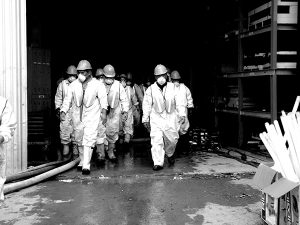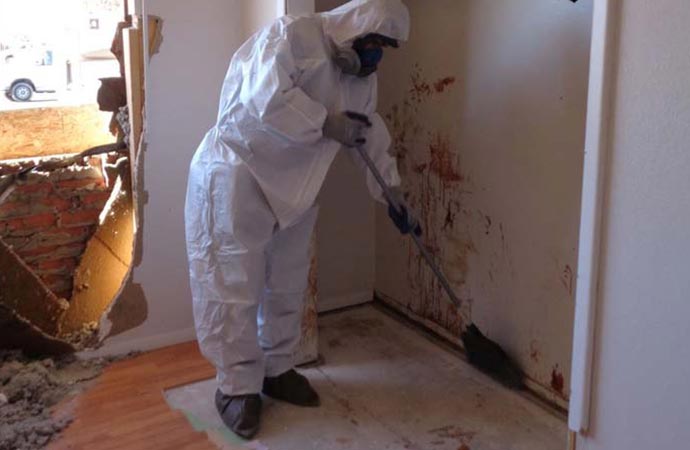Clandestine Lab Cleanup: Comprehensive Decontamination for Hazardous Sites
Clandestine Lab Cleanup: Comprehensive Decontamination for Hazardous Sites
Blog Article
Expert Biohazard Cleaning and Decontamination for Blood, Bodily Fluids, and Hazardous Materials
The potential health and wellness threats connected with direct exposure to biohazards underscore the important need for careful handling and thorough clean-up. As we browse the intricate landscape of biohazard clean-up, recognizing the nuances of policies, conformity, and the specialized equipment at play ends up being essential in making sure a extensive and secure decontamination process.
Health And Wellness Dangers of Biohazard Direct Exposure
Direct exposure to biohazards poses significant health and wellness dangers that can cause extreme consequences for neighborhoods and people alike. Biohazards incorporate a vast array of biological substances, including blood, bodily fluids, mold, germs, viruses, and other potentially contagious materials. When individuals enter contact with these biohazards, whether with mishaps, incorrect handling, or environmental exposure, they face the risk of contracting major diseases or illness.
One of the primary health risks associated with biohazard direct exposure is the transmission of transmittable conditions. Bloodborne virus such as HIV, liver disease B and C, and different germs can be present in biohazardous materials, posing a straight hazard to human wellness. Breathing in airborne biohazards like mold spores or coming right into call with infected surfaces can also lead to respiratory system concerns, allergic reactions, and other adverse health results.
Moreover, biohazard exposure can have long-term wellness ramifications, with some diseases showing up years after the first get in touch with (Blood Cleanup). Therefore, it is critical to focus on proper biohazard cleansing and decontamination to mitigate these wellness dangers and ensure the safety and security of neighborhoods and individuals

Specialized Training for Biohazard Cleaning
When it comes to managing biohazard cleaning efficiently and safely, specialized training plays a basic role in making sure correct decontamination procedures are complied with. Biohazard cleaning requires particular understanding and abilities to effectively reduce dangers connected with bloodborne pathogens, bodily fluids, and dangerous products. Specialists trained in biohazard cleaning undertake rigorous guideline on just how to safely deal with, get rid of, and throw away biohazardous materials to stop contamination and exposure.
Specialized training for biohazard clean-up covers a variety of vital topics, including proper personal protective tools (PPE) usage, bloodborne microorganism understanding, decontamination methods, and harmful waste disposal procedures. People learnt biohazard clean-up are furnished with the needed experience to analyze contamination degrees, recognize possible dangers, and carry out proper clean-up procedures in compliance with governing criteria.
Continual training and education are critical in the field of biohazard cleanup to remain upgraded on the newest decontamination technologies, safety and security procedures, and policies. By buying specialized training, biohazard cleaning specialists can efficiently respond to emergency situation clean-up situations and safeguard both public wellness and the atmosphere.
Significance of Correct Purification Techniques
Making use of appropriate decontamination strategies is important in biohazard cleanup to properly minimize and get rid of hazardous products health and wellness threats. Efficient decontamination not only ensures the elimination of visible traces of blood, physical fluids, and various other biohazards but additionally targets unnoticeable virus that may posture major health dangers if not effectively eliminated. By following rigid decontamination methods, trained specialists can considerably lower the risk of direct exposure to dangerous bacteria, infections, and germs that can lead to infections or conditions.
Appropriate purification methods entail using specific equipment and disinfectants that are especially developed to counteract biohazards effectively. Complete cleaning and disinfection of infected areas are vital to avoid the spread of microorganisms and guarantee a secure environment for passengers. In addition, the right disposal of biohazardous waste following decontamination treatments is vital in protecting against contamination of other surface areas or individuals.

Devices and Tools for Safe Cleaning
The proper devices and tools play a vital function in guaranteeing the safe and effective clean-up of biohazardous materials. When dealing with blood, physical fluids, or dangerous materials, biohazard cleaning professionals my sources depend on specialized gear to minimize direct exposure dangers and thoroughly decontaminate the afflicted location. Personal protective tools (PPE) such as gloves, masks, coveralls, and goggles are vital to protect versus direct contact with possibly contagious materials. In addition, biohazard cleaning packages consisting of disinfectants, absorbing materials, and biohazard bags are made use of to safely get rid of and contain of infected items. Blood Cleanup.
Advanced cleaning devices like hospital-grade anti-bacterials, HEPA-filtered vacuums, and fogging makers are used to sanitize surfaces and eliminate biohazards properly. Specialized equipment such as sharps containers and biohazard waste disposal containers are made use of to securely manage sharp objects and biohazardous waste materials. By using the appropriate equipment and tools, biohazard cleaning experts can make sure a comprehensive clean-up process that focuses on safety and security and decreases health risks for both workers and residents of the afflicted area.
Laws and Conformity in Biohazard Cleansing
Correct adherence to laws and conformity criteria is paramount in biohazard cleaning to ensure the safety of both personnel and the environment. Government agencies such as OSHA (Occupational Safety and Health Management) and the EPA (Epa) have actually developed certain standards for biohazard clean-up procedures to reduce health risks and ecological contamination. These laws cover an array of elements including the handling, transportation, and disposal of biohazardous materials, along with the essential training and safety tools required for personnel associated with the clean-up process.
Biohazard cleaning firms need to stay up-to-date with these laws to ensure that their operations meet the called for security standards. Failing to comply with these laws can lead to severe consequences, consisting of fines, lawsuit, and endangering the wellness of individuals and the setting. By complying with strict laws and conformity procedures, biohazard cleansing firms can efficiently mitigate threats and guarantee a comprehensive and secure clean-up process for all events involved.
Verdict
To conclude, biohazard cleansing and decontamination need specialized training, appropriate strategies, and adherence to policies. Direct exposure to blood, bodily fluids, and unsafe materials presents substantial health threats, making it crucial to utilize the appropriate equipment and devices for secure cleanup. By following rigorous methods and guidelines, professionals can efficiently mitigate the threats connected with biohazard direct exposure and make sure the safety of both themselves and others.
As we navigate the complex landscape of biohazard cleanup, recognizing the subtleties of policies, compliance, and the specialized devices at play comes to be crucial in guaranteeing a comprehensive and secure decontamination process. (Blood Cleanup)
When it comes to taking care of biohazard cleanup efficiently and safely, specialized training plays a fundamental function in making certain proper purification procedures are followed.Utilizing proper purification strategies is important in biohazard clean-up to properly lessen and get rid of dangerous materials health risks. Additionally, biohazard cleansing packages having directory anti-bacterials, absorptive materials, and biohazard bags are used to safely dispose and consist of of polluted products.
Government agencies such as OSHA (Occupational Safety And Security and Health And Wellness Administration) and the EPA (Environmental Protection Firm) have actually why not try this out established specific standards for biohazard clean-up treatments to minimize health risks and ecological contamination.
Report this page